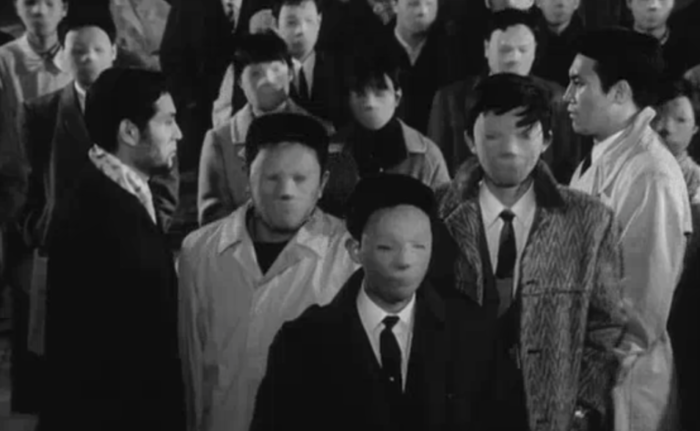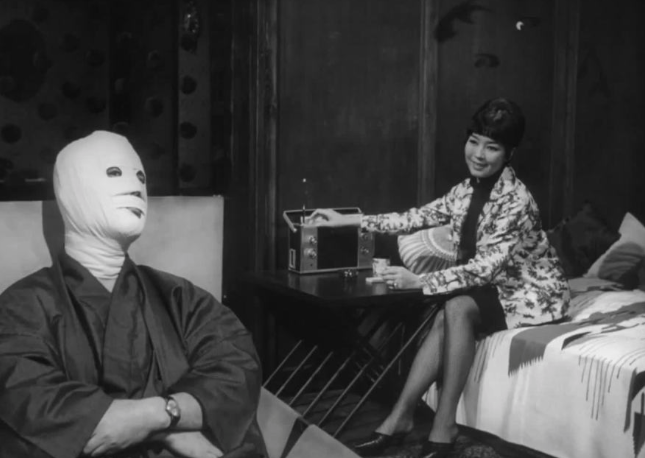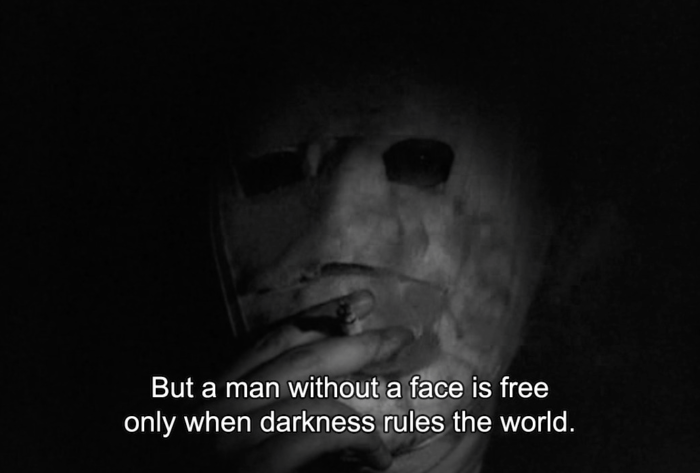
“We all have a social mask, right? We put it on, we go out, put our best foot forward, our best image. But behind that social mask is a personal truth, what we really, really believe about who we are and what we’re capable of.” That’s a quote from one of the greatest minds of our time, Dr. Phil. Though I have no respect whatsoever towards Dr. Phil as a medical professional, I figure that quote is as good as any way to start a review about a surrealist Japanese film from the 1960s.
Exploring the annals of the Criterion Collection website, I was drawn to The Face of Another from the striking image on its personal page. I’ll post it below so you can experience it as I did.
As a horror movie fan, I was instantly taken aback by this stark black and white image of two men meeting eye to eye in a sea of blank faces. I don’t think I’m spoiling anything by saying this image (which is at the end of the film) perfectly represents everything The Face of Another stands for. I won’t spoil what it all means, but I will give you a hint along with my take on this skin crawling classic from Japanese New Wave director Hiroshi Teshigahara and surrealist writer Kōbō Abe.
Released in 1966, The Face of Another is the third in a series of adaptations from Hiroshi Teshigahara of Kōbō Abe’s fiction. Meaning it all starts with Abe. Though I haven’t read any of his books I feel like you can learn a lot just from brief plot summaries. Take this one “A Man and his son wander into a deserted town for work, only to join a population of lost souls,” or “An entomologist on vacation is trapped by local villagers into living with a woman whose life task is shoveling sand for them.”
These are the plots of the books (and they’re adaptations) Pitfall (1962) and Woman in the Dunes (1964), both directed by Hiroshi Teshigahara and both adapted for the screen by the original author Kôbô Abe. How about this one “A nameless protagonist gives up his identity and the trappings of a normal life to live in a large cardboard box he wears over his head.” That one isn’t a movie (yet) but I think you’re getting the idea.
Kôbô Abe has been described as a Kafkaesque modernist renowned for his long philosophical ruminations and darkly humored dissections of the human psyche. In the case The Face of Another, it’s the theme of identity. People judge other people every day by their faces and overall appearance, but does that really define us? Who are we outside our own skin? These are some of the ideas explored through conversation and avant-garde imagery in this deeply engrossing piece of modern sci-fi. And don’t think just because I used the term “sci fi” that this is a basic genre picture.
The plot is relatively simple. Mr. Okuyama (Tatsuya Nakadai) is a thirtysomething chemist (according to the book) who before the events of the film is horribly deformed from an industrial accident. We pick up with Mr. Okuyama at home, brooding and ranting to his dispirited wife Mrs. Okuyama (Machiko Kyō) about the loss of his identity and the idea of a face as a “mask.”
Mr. Okuyama uses analogies such as the executioner’s mask and a hijab in regards to identity, but most notable is Mrs. Okuyama’s comment that every woman has to wear a mask every day by wearing makeup. The conversations are interesting if not a little creepy with Mr. Okuyama’s fatalistic view on the world and cold, emotionless laugh. For a performance that’s about 80% voice and body language for the first half of the film, Tatsuya Nakadai really grabs your cojones.
Enter the “sci fi” portion of the story where Mr. Okuyama’s doctor, Dr. Hira (Mikijirō Hira), suggests a hyper-realistic mask. Mr. Okuyama agrees, they pay some rando to make a mold of their face and plop the newly minted piece of rubber over Mr. Okuyama’s scarred visage. Of course, to accomplish the effect the film switches to using Nakadai’s real face but they add a few imperfections such as spots around the eyes and a crease around the neck that must be hidden with a neckbeard. So there ya go, that’s that, right?
Wrong. Though Mr. Okuyama has a face he still doesn’t feel like he’s found his own skin. Probably because he is literally in someone else’s. Thus, Okuyama goes on a journey of self-discovery, which includes meeting with old work associates to see if they can recognize him or even crazier, seduces his wife as a new man. I think you can guess that neither of these adventures or “misadventures” pan out and send Mr. Okuyama down a darker and deeper emotional spiral.
A few months ago here at Mildly Pleased, we did a podcast announcing our picks for Criterion Month. Sean wondered if this film was in some way a reaction or reflection of living in a post-atomic bomb Japan. I can now affirm his guess was 100% correct. There’s even a b-plot separate from Mr. Okuyama’s story about a gorgeous Nurse (Kyōko Kishida), apart from a horrible war wound, caring for disabled veterans in a hospital by the sea. Though the Nurse’s story never intertwines with Mr. Okuyama’s, both share the idea of trying to reclaim a life after so much as been taken away.
There are many interpretations of the events at play here. I only hope I’m not way off base with any of my conclusions. The Face of Another is a film that I believe would benefit from repeat viewings. Not only to appreciate everything it has to say but how it chooses to express itself visually. I haven’t gone much into it but this film is a cinematographer’s wet dream… or maybe a wet nightmare.
The most memorable visual in the film has to be Dr. Hira’s lab. It’s like a white and gray void of nothingness with random desks, tables, and glass partitions decorated with drawings of the Vitruvian Man and Langer’s lines. The cover of the Criterion is a shot of Mr. Okuyama looking through glass with Langer’s lines.
There’s too much to go into now and I’m running out of time but I would highly recommend this film. I’m actually disappointed I’m not watching any other Teshigahara/Abe collaborations. Apparently, not only are all four of their collaborations in the Criterion Collection, but The Face of Another is also part of a box set with Pitfall and Woman in the Dunes (a film that received a nomination for Best Foreign Film and Best Director at the Oscars back in the day). But if you’re lazy you can probably get away with just watching Face-Off because it’s basically the same thing.
Ultimate nightmare fodder.






